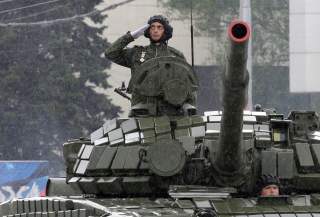Not Good: War Game Shows How NATO Could Lose a War to Russia
What can be done to stop this from happening?
Key point: Russia's conventional forces could overwhelm those defending the Baltics. If that happened, it would be hard for America to push them out.
A recent RAND wargame on a potential Russian offensive into the Baltics brought talk of a “new Cold War” into sharp focus. The game made clear that NATO would struggle to prevent Russian forces from occupying the Baltics if it relied on the conventional forces now available.
This first appeared earlier in 2017 and is being reposted due to reader interest.
Recommended: Russia's Battlecruisers Could Be a Super Weapon
These wargames have great value in demonstrating tactical and operational reality, which then informs broader strategic thinking. In this case, however, the headlines generated by the game have obscured more about the NATO-Russian relationship than they have revealed. In short, the NATO deterrent promise has never revolved around a commitment to defeat Soviet/Russian forces on NATO’s borders. Instead, NATO has backed its political commitment with the threat to broaden any conflict beyond the war that the Soviets wanted to fight. Today, as in 1949, NATO offers deterrence through the promise of escalation.
Recommended: A Hypersonic Arms Race is Coming.
The Early Years
Let’s be utterly clear on this point; from the creation of NATO until the 1970s, Western military planners expected the Warsaw Pact to easily win a conventional war in Europe. Conventional warfighting plans by the major NATO powers often amounted, almost literally, to efforts to reach the English Channel just ahead of the tanks of the Red Army. NATO expected to liberally use tactical nuclear weapons to slow the Soviet advance, an action which would inevitably invite Soviet response (the Soviets also prepared for this dynamic).
Recommended: Report - U.S. Army is Now "Weak"
The belief that NATO would lose a conventional conflict did nothing to contradict the notion that NATO could play a valuable role in deterring war. For one, NATO could certainly make things more difficult for the Soviet Union; overwhelming combined British-German-American forces would prove far more costly than defeating a West Germany that stood alone. Moreover, by triggering an expansion of the war NATO could create costs for the Soviets in other parts of the world. Overwhelming NATO superiority at sea and in long-range airpower would prove devastating for Soviet interests outside of Eurasia, even if the Soviets prevailed on the Central Front.
Most importantly, the threat that France, Britain and the United States would launch strategic nuclear strikes on the Soviet Union in response to a successful conventional assault was supposed to give Moscow pause. Even if an American President refused to exchange Berlin for New York, the Soviets would have to worry about the rest of NATO’s nuclear deterrent.
Active Defense/AirLand Battle
The expectation that NATO could defeat the Warsaw Pact in battle only emerged after the Yom Kippur War. In that conflict, precision-guided conventional munitions exacted such a toll on advancing forces (both in the Golan and in Sinai) that American military planners began to believe that they could stop a Soviet attack. Drawn up in defensive positions that would channel oncoming Red Army armor into large kill zones, NATO forces could sufficiently blunt and disrupt a Soviet advance, and prevent the collapse of positions within Germany. The defense would buy time for NATO to transit additional forces and equipment from the United States to Europe, to carry out in depth attacks against Warsaw Pact logistical and communications centers in Eastern Europe, and to attack Soviet interests in the rest of the world.
After 1982, AirLand Battle would return maneuver to the battlefield, as American commanders grew more confident of their ability to defeat the Red Army in a fluid engagement. Cooperation between the Army and the Air Force would allow attacks all along the depth of the Soviet position, turning the formidable Red Army (and its Eastern European allies) into a chaotic mess. At the same time, the U.S. Navy prepared to attack directly into the Soviet periphery with airstrikes and amphibious assaults, as well as into the cherished “bastions” of the Soviet boomer fleet. None of this depended on the protection of any given piece of NATO territory; planners accepted that the Soviets could make at least some gains at the beginning of any plausible war scenario.
In this context, news that Russia could win a localized conventional conflict against small NATO nations on its border becomes rather less alarming than it sounds at first blush. Apart from (perhaps) a brief window of vulnerability in the 1990s, Russia has always had the capacity to threaten NATO with conventional force. Indeed, NATO did not even begin to plan for the conventional defense of the Baltics until well after their accession, on the belief that the faith and credit of the alliance, and in particular its ability to retaliate against Soviet interests in the rest of Europe, would prove a sufficient deterrent.
The RAND wargame suggests that Russia could take the Baltics, and perhaps hold them, for a while. Moscow would begin to pay costs very early in any conflict, however, as NATO forces moved against Kaliningrad, Transnistria and other Russian holdings. The Russian Navy would likely come under severe attack from NATO submarines and aircraft. Long range strikes would debilitate much of the rest of Russia’s air force and air defense network. In short, Russia could grab the Baltics, but only at a cost vastly in excess of the value of holding onto them. This is how NATO conducted deterrence in 1949, and it’s how NATO does deterrence today.
Robert Farley, a frequent contributor to the National Interest, is author of The Battleship Book. He serves as a Senior Lecturer at the Patterson School of Diplomacy and International Commerce at the University of Kentucky.
This first appeared earlier in 2017 and is being reposted due to reader interest.
Image: Reuters

